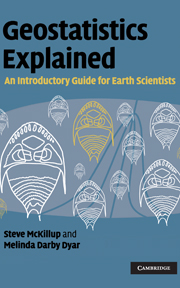Book contents
- Frontmatter
- Contents
- Preface
- 1 Introduction
- 2 “Doing science”: hypotheses, experiments and disproof
- 3 Collecting and displaying data
- 4 Introductory concepts of experimental design
- 5 Doing science responsibly and ethically
- 6 Probability helps you make a decision about your results
- 7 Working from samples: data, populations and statistics
- 8 Normal distributions: tests for comparing the means of one and two samples
- 9 Type 1 and Type 2 error, power and sample size
- 10 Single-factor analysis of variance
- 11 Multiple comparisons after ANOVA
- 12 Two-factor analysis of variance
- 13 Important assumptions of analysis of variance, transformations and a test for equality of variances
- 14 Two-factor analysis of variance without replication, and nested analysis of variance
- 15 Relationships between variables: linear correlation and linear regression
- 16 Linear regression
- 17 Non-parametric statistics
- 18 Non-parametric tests for nominal scale data
- 19 Non-parametric tests for ratio, interval or ordinal scale data
- 20 Introductory concepts of multivariate analysis
- 21 Introductory concepts of sequence analysis
- 22 Introductory concepts of spatial analysis
- 23 Choosing a test
- Appendices
- References
- Index
15 - Relationships between variables: linear correlation and linear regression
Published online by Cambridge University Press: 05 June 2012
- Frontmatter
- Contents
- Preface
- 1 Introduction
- 2 “Doing science”: hypotheses, experiments and disproof
- 3 Collecting and displaying data
- 4 Introductory concepts of experimental design
- 5 Doing science responsibly and ethically
- 6 Probability helps you make a decision about your results
- 7 Working from samples: data, populations and statistics
- 8 Normal distributions: tests for comparing the means of one and two samples
- 9 Type 1 and Type 2 error, power and sample size
- 10 Single-factor analysis of variance
- 11 Multiple comparisons after ANOVA
- 12 Two-factor analysis of variance
- 13 Important assumptions of analysis of variance, transformations and a test for equality of variances
- 14 Two-factor analysis of variance without replication, and nested analysis of variance
- 15 Relationships between variables: linear correlation and linear regression
- 16 Linear regression
- 17 Non-parametric statistics
- 18 Non-parametric tests for nominal scale data
- 19 Non-parametric tests for ratio, interval or ordinal scale data
- 20 Introductory concepts of multivariate analysis
- 21 Introductory concepts of sequence analysis
- 22 Introductory concepts of spatial analysis
- 23 Choosing a test
- Appendices
- References
- Index
Summary
Introduction
Often earth scientists obtain data for a sample where two or more variables have been measured on each sampling or experimental unit, because they are interested in whether these variables are related and, if so, the type of functional relationship between them.
If two variables are related they vary together – as the value of one variable increases or decreases, the other also changes in a consistent way.
If two variables are functionally related, they vary together and the value of one variable can be predicted from the value of the other.
To detect a relationship between two variables, both are measured on each of several subjects or experimental units and these bivariate data examined to see if there is any pattern. One way to do this, by drawing a scatter plot with one variable on the X axis and the other on the Y axis, was described in Chapter 3. Although this can reveal patterns, it does not show whether two variables are significantly related, or have a significant functional relationship. This is another case where you have to use a statistical test, because an apparent relationship between two variables may only have occurred by chance in a sample from a population where there is no relationship. A statistic will indicate the strength of the relationship, together with the probability of getting that particular result, or an outcome even more extreme, in a sample from a population where there is no relationship between the two variables.
- Type
- Chapter
- Information
- Geostatistics ExplainedAn Introductory Guide for Earth Scientists, pp. 194 - 203Publisher: Cambridge University PressPrint publication year: 2010



